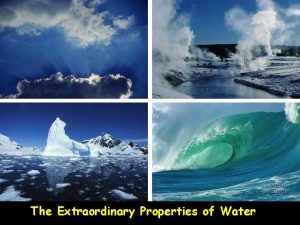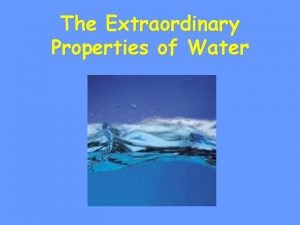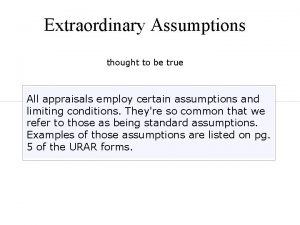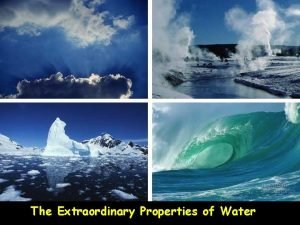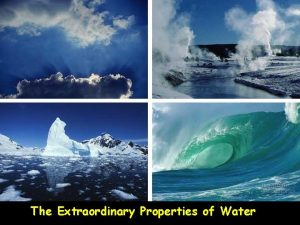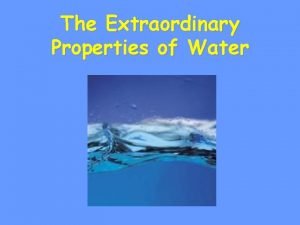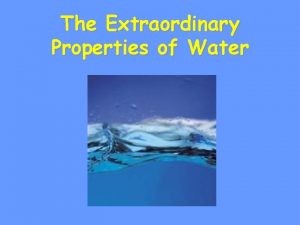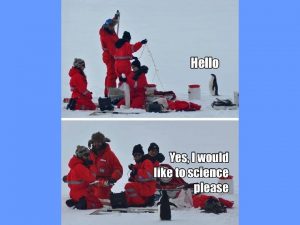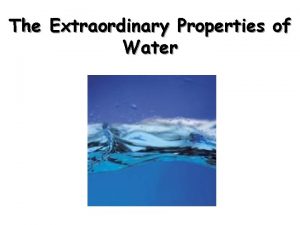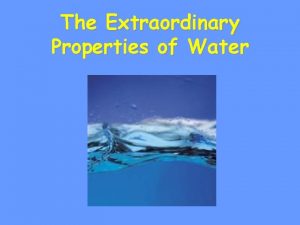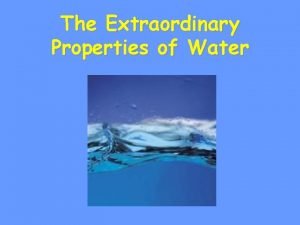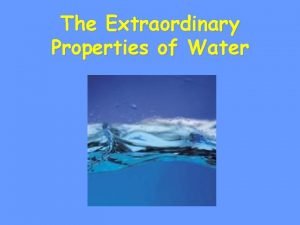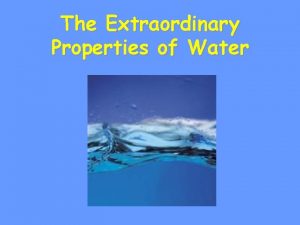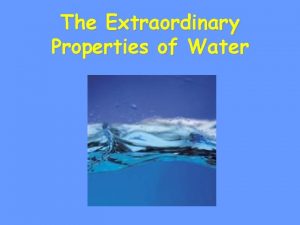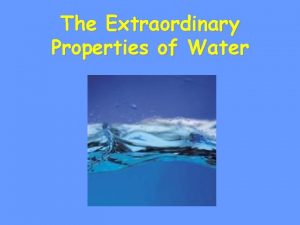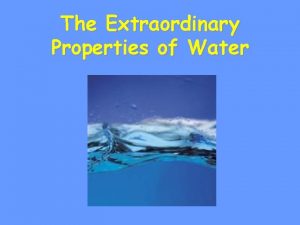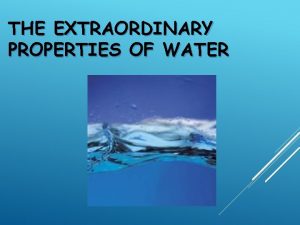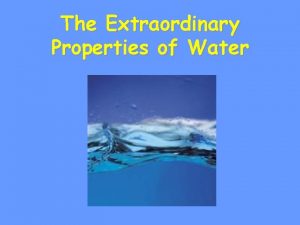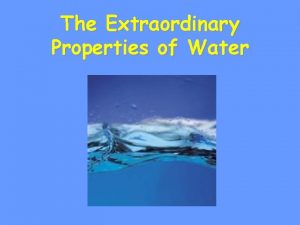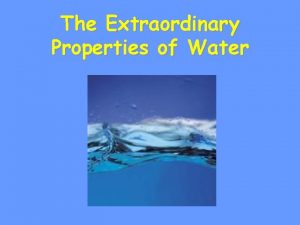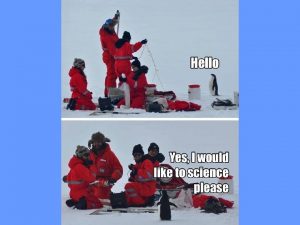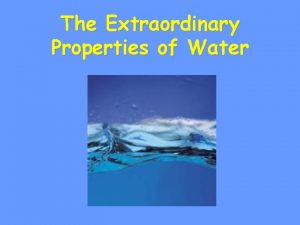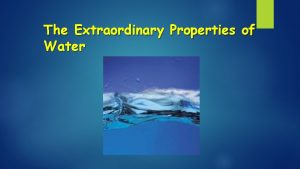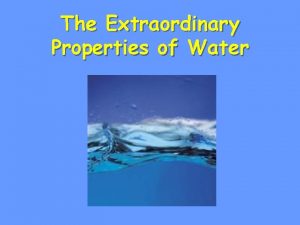The Extraordinary Properties of Water Water A water


























- Slides: 26

The Extraordinary Properties of Water

Water • A water molecule (H 2 O), is made up of three atoms --- one oxygen and two hydrogen. H O H

Water is Polar • • The oxygen end “acts” negative The hydrogen end “acts” positive Causes the water to be POLAR However, Water is neutral (equal number of e- and p+) --- Zero Net Charge

Hydrogen Bonds Exist Between Water Molecules • Formed between a highly Electronegative atom of a polar molecule and a Hydrogen • One hydrogen bond is weak, but many hydrogen bonds are strong

Interaction Between Water Molecules Negative Oxygen end of one water molecule is attracted to the Positive Hydrogen end of another water molecule to form a HYDROGEN BOND

What are the Properties of Water?

Properties of Water • Cohesion • Adhesion • High Specific Heat • High Heat of Vaporization • Less Dense as a Solid

Cohesion • Attraction between particles of the same substance ( why water is attracted to itself) • Results in Surface tension (a measure of the strength of water’s surface) • Produces a surface film on water that allows insects to walk on the surface of water

Cohesion … Helps insects walk across water

Adhesion • Attraction between two different substances. • Water will make hydrogen bonds with other surfaces such as glass, soil, plant tissues, and cotton. • Capillary action-water molecules will “tow” each other along when in a thin glass tube. • Example: transpiration process which plants and trees remove water from the soil, and paper towels soak up water.

Adhesion Causes Capillary Action Which gives water the ability to “climb” structures

Adhesion Also Causes Water to … Form spheres & hold onto plant leaves Attach to a silken spider web

High Specific Heat • Amount of heat needed to raise or lower 1 g of a substance 1° C. • Water resists temperature change, both for heating and cooling. • Water can absorb or release large amounts of heat energy with little change in actual temperature.

Evaporative Cooling -Moderates temperature: land near the ocean stays warmer in winter and cooler in summer -When we sweat, the moisture on our skin evaporates and helps cool us down.

Water is Less Dense as a Solid • Ice is less dense as a solid than as a liquid (ice floats) • Liquid water has hydrogen bonds that are constantly being broken and reformed. • Frozen water forms a crystal-like lattice whereby molecules are set at fixed distances.

Water is Less Dense as a Solid • Which is ice and which is water?

Water is Less Dense as a Solid Water Ice

Homeostasis • Ability to maintain a steady state despite changing conditions • Water is important to this process because: a. Makes a good insulator b. Resists temperature change c. Universal solvent- more substances dissolve in water than any other chemical d. Coolant e. Ice protects against temperature extremes (insulates frozen lakes)

Solutions & Suspensions • Water is usually part of a mixture. • There are two types of mixtures: – Solutions – Suspensions

Solution • Ionic compounds disperse as ions in water • Evenly distributed • SOLUTE – Substance that is being dissolved • SOLVENT – Substance into which the solute dissolves

Solution

Solvent of Life • Water dissolves other polar substances (These are hydrophilic- they are attracted to water. ) • It does not dissolves hydrophobic substances. (These are repelled by water. )

Suspensions • Substances that don’t dissolve but separate into tiny pieces. • Water keeps the pieces suspended so they don’t settle out.

Acids • Strong Acids have a p. H of 1 -3 • Produce lots of H+ ions

Bases • Strong Bases have a p. H of 11 to 14 • Contain lots of OH-ions (hydroxide) and fewer H+ ions

 The extraordinary properties of water
The extraordinary properties of water The extraordinary properties of water
The extraordinary properties of water Water and water and water water
Water and water and water water Are kangaroos dangerous
Are kangaroos dangerous Extraordinary life quotes
Extraordinary life quotes 4 obsessions of an extraordinary executive summary
4 obsessions of an extraordinary executive summary Extraordinary assumption
Extraordinary assumption Creating extraordinary teams
Creating extraordinary teams Player connotation
Player connotation Tight denotation and connotation
Tight denotation and connotation Closing prayer for class
Closing prayer for class Clearvoiceresearch
Clearvoiceresearch Intensive vs extensive properties
Intensive vs extensive properties Chemical and physical properties
Chemical and physical properties Hình ảnh bộ gõ cơ thể búng tay
Hình ảnh bộ gõ cơ thể búng tay Bổ thể
Bổ thể Tỉ lệ cơ thể trẻ em
Tỉ lệ cơ thể trẻ em Voi kéo gỗ như thế nào
Voi kéo gỗ như thế nào Chụp phim tư thế worms-breton
Chụp phim tư thế worms-breton Hát lên người ơi alleluia
Hát lên người ơi alleluia Các môn thể thao bắt đầu bằng tiếng bóng
Các môn thể thao bắt đầu bằng tiếng bóng Thế nào là hệ số cao nhất
Thế nào là hệ số cao nhất Các châu lục và đại dương trên thế giới
Các châu lục và đại dương trên thế giới Công của trọng lực
Công của trọng lực Trời xanh đây là của chúng ta thể thơ
Trời xanh đây là của chúng ta thể thơ Cách giải mật thư tọa độ
Cách giải mật thư tọa độ
